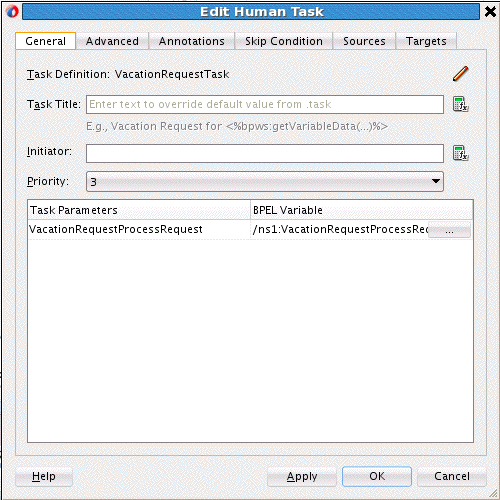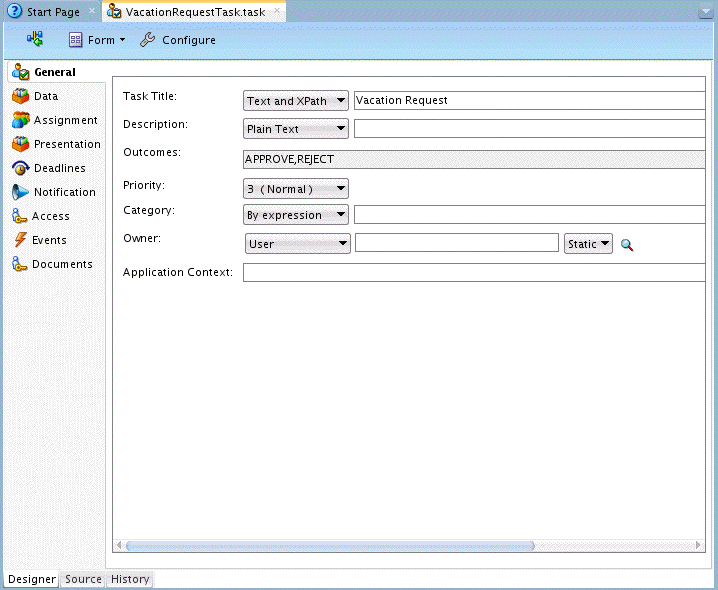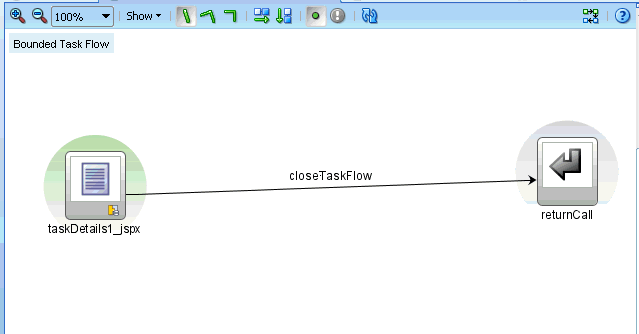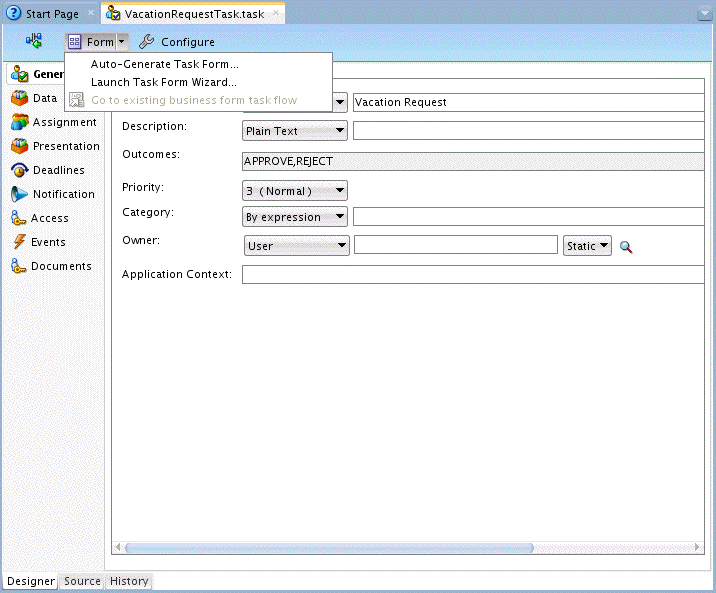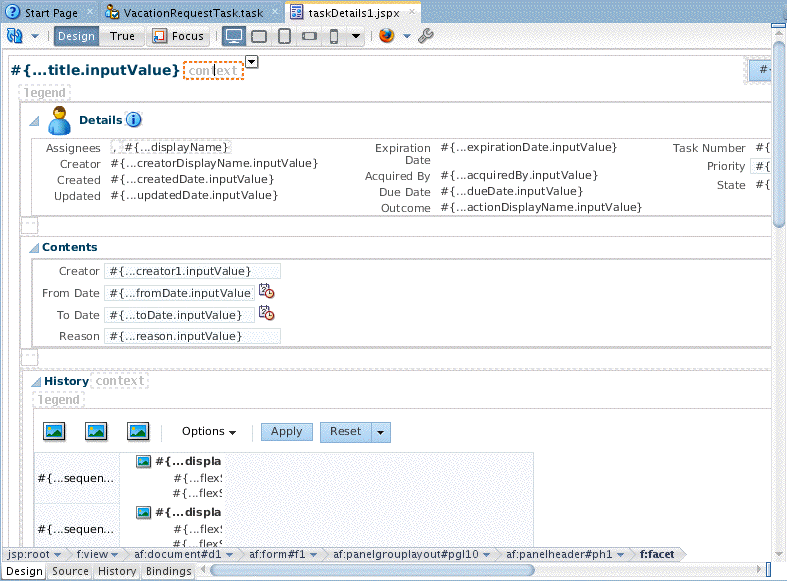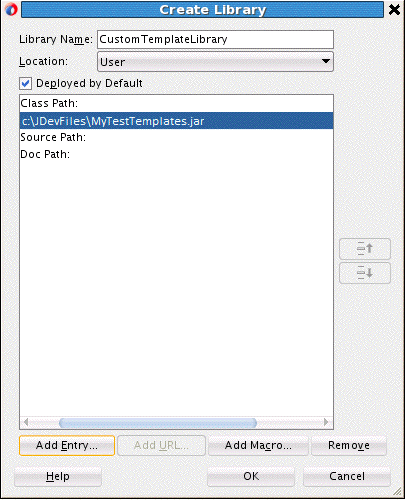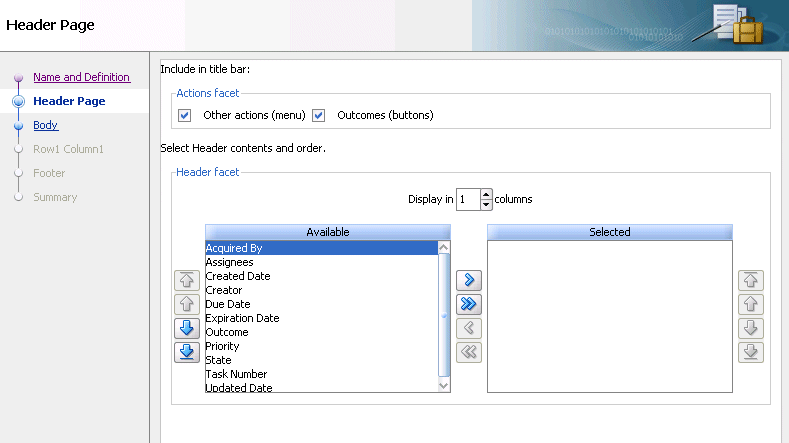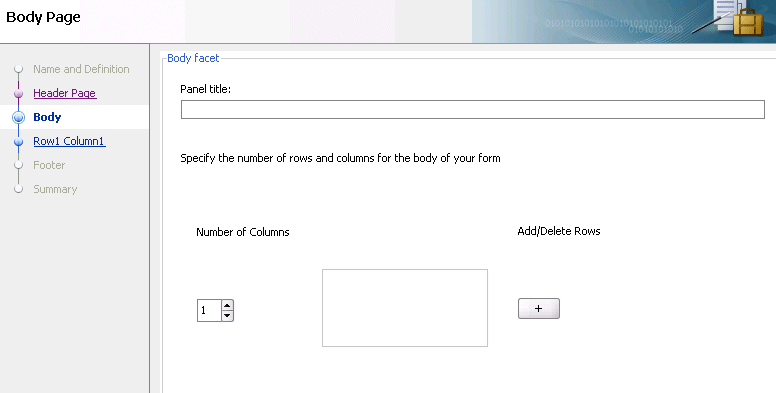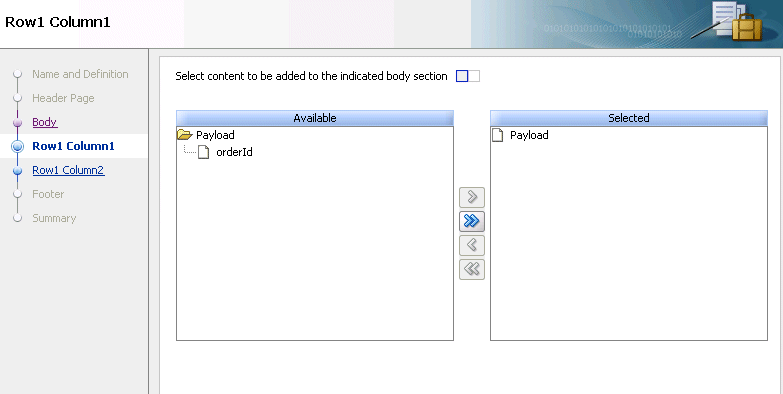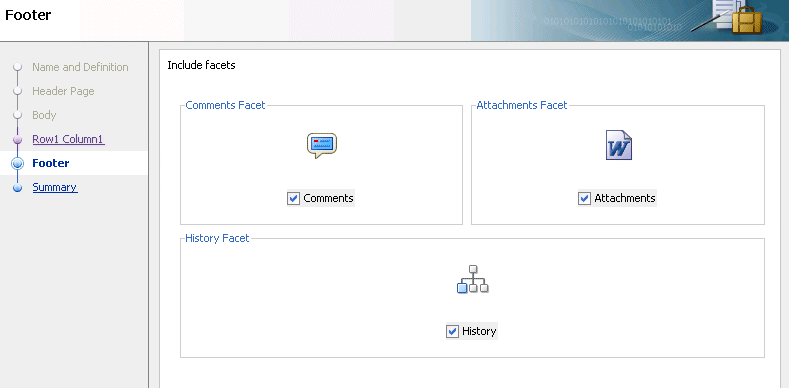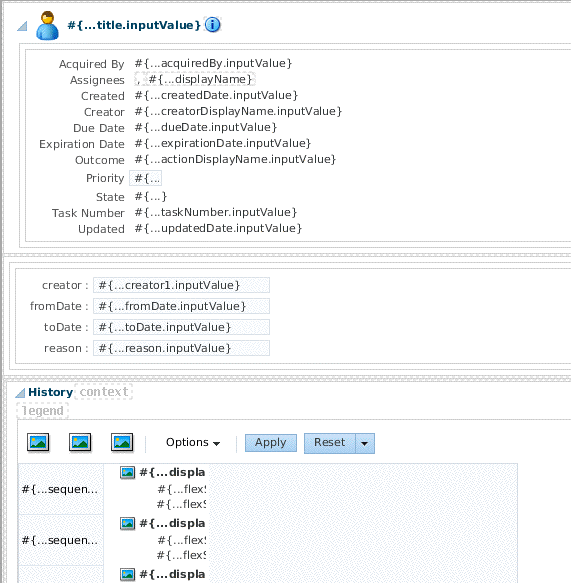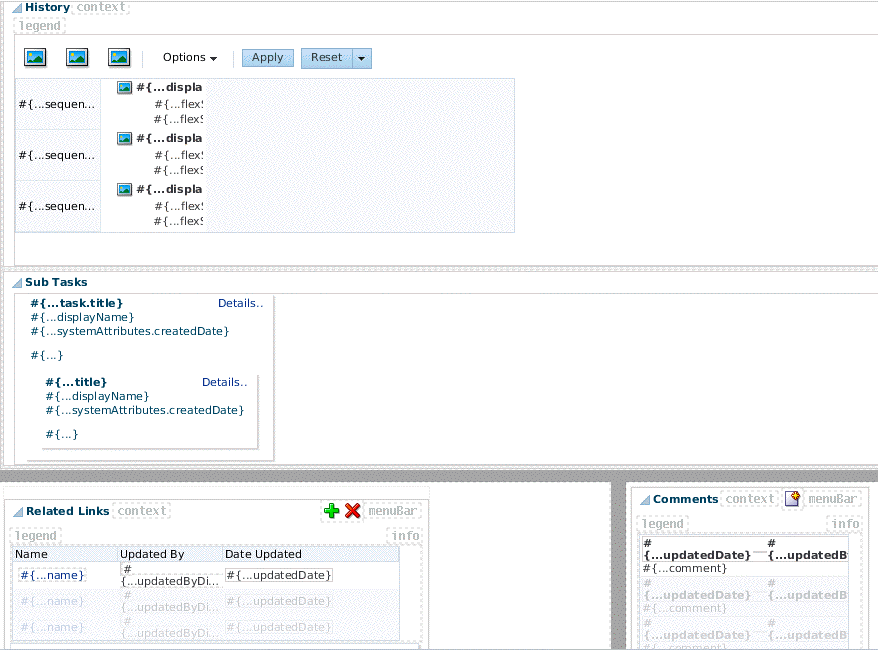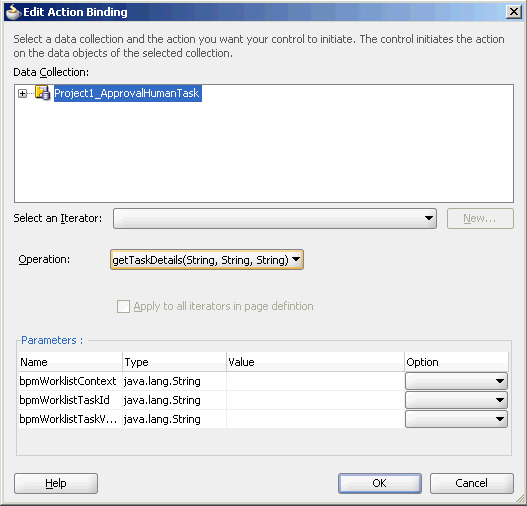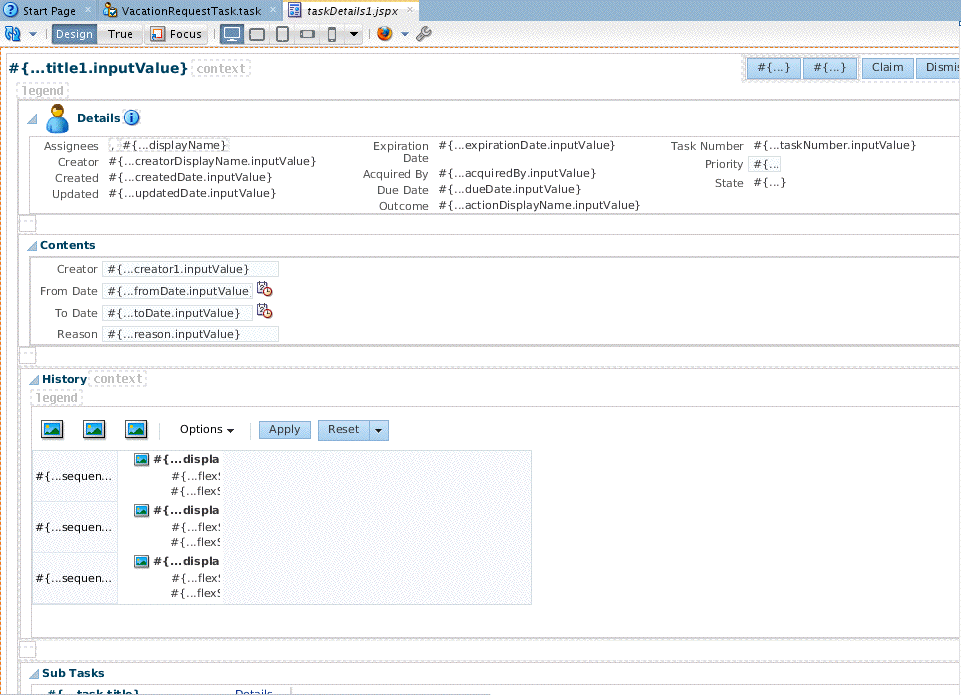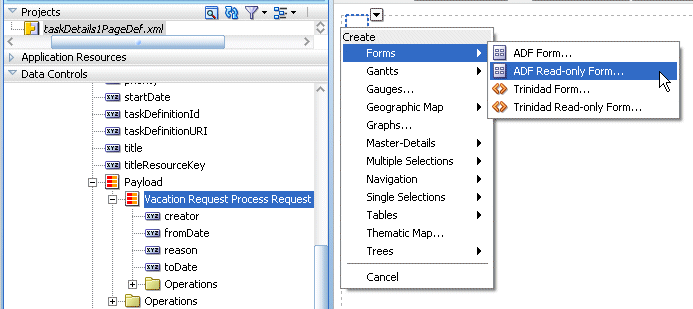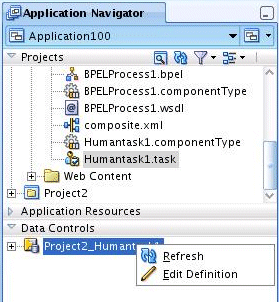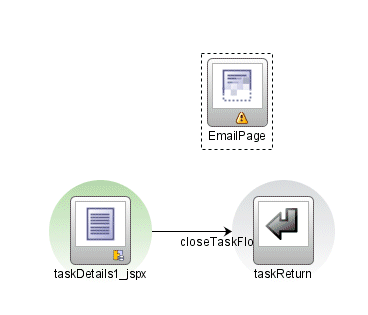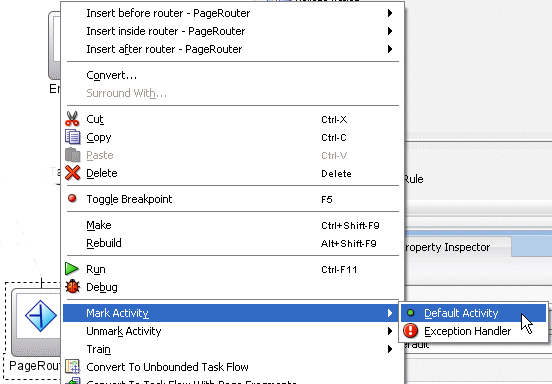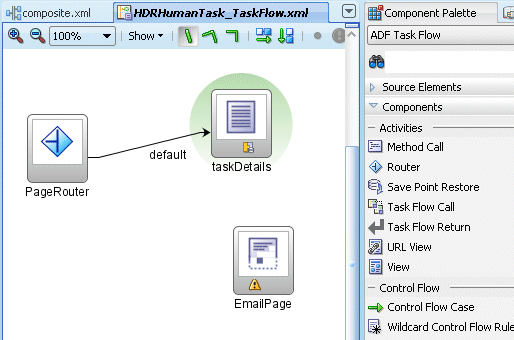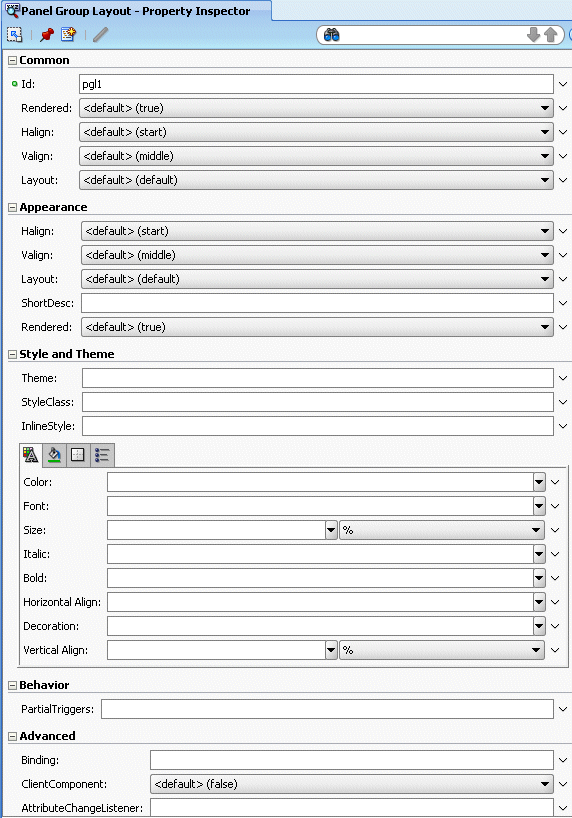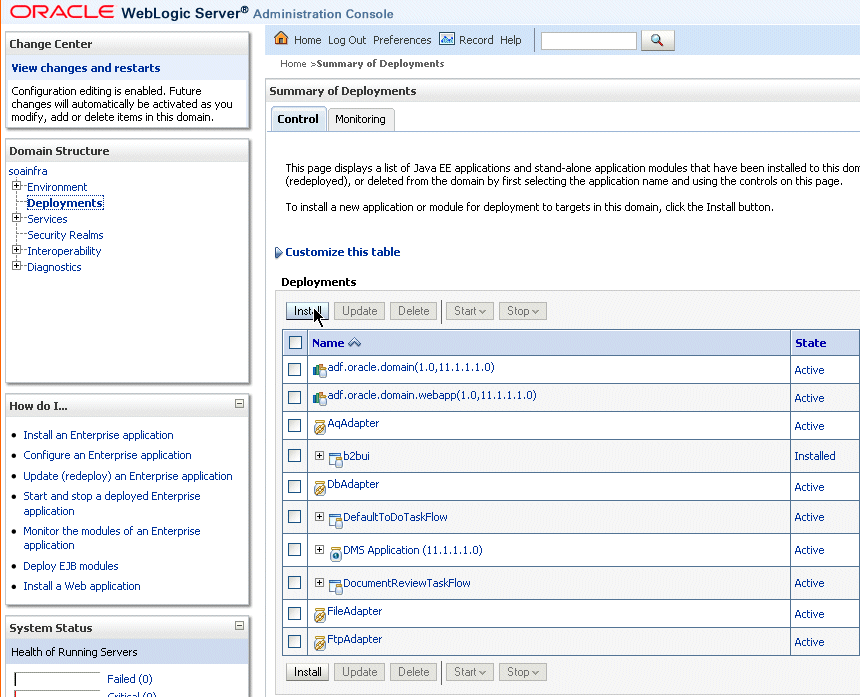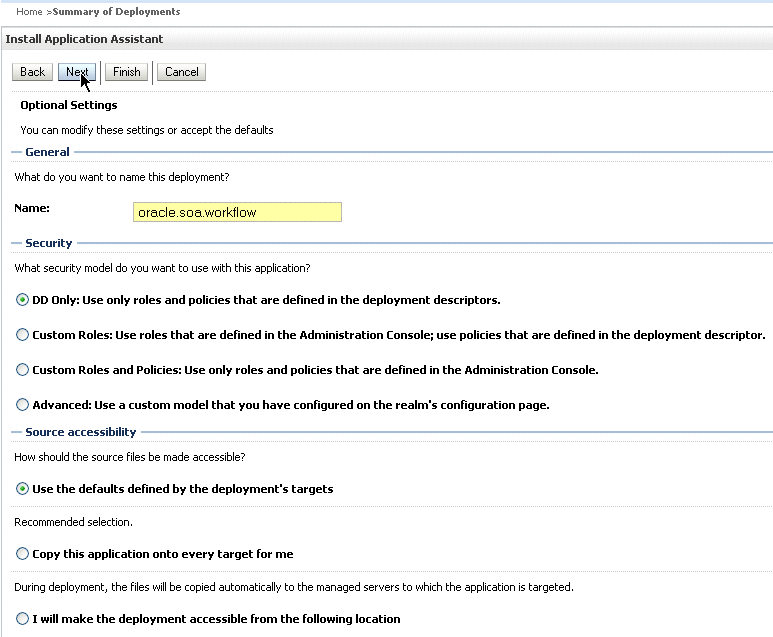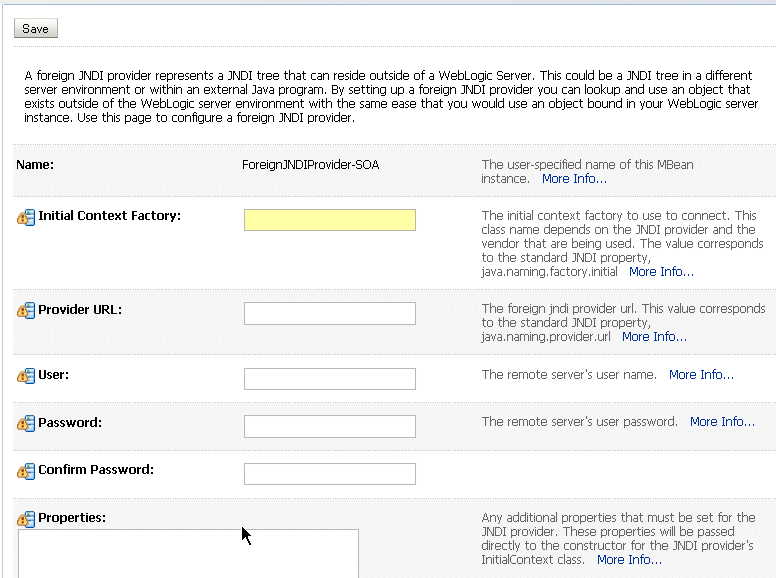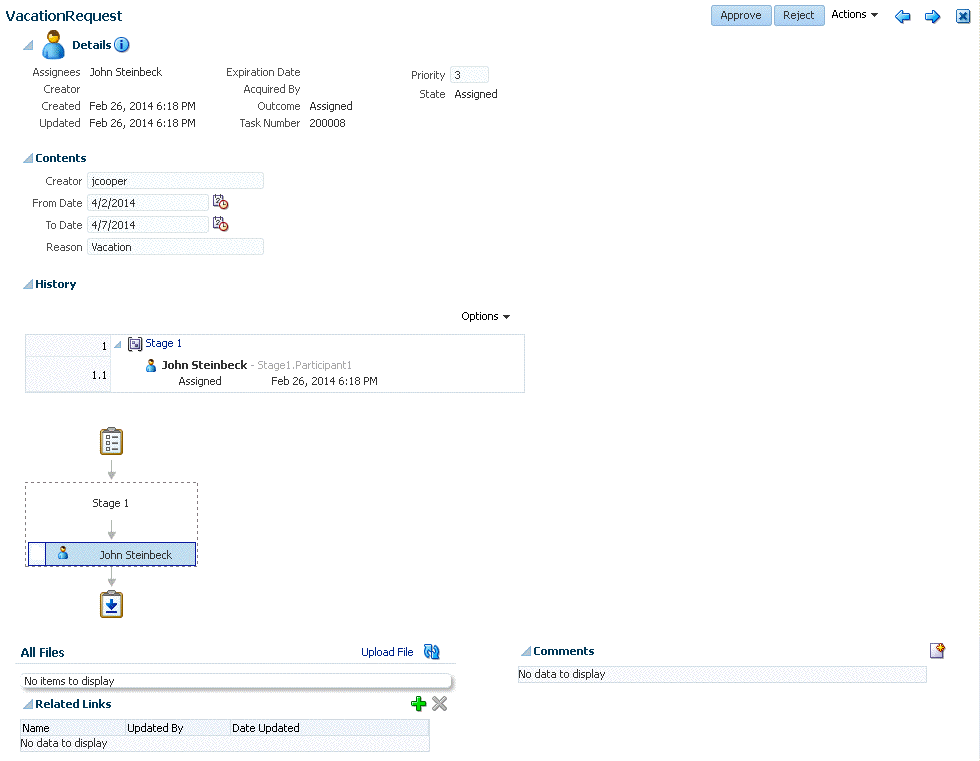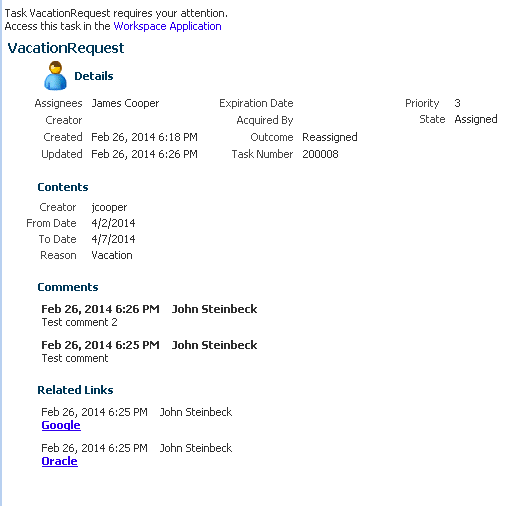30 Designing Task Forms for Human Tasks
Oracle BPM Worklist displays all worklist tasks that are assigned to a user or a group. When a worklist user drills down into a specific task, the task form renders the details of that task.
For information about troubleshooting human workflow issues, see section "Human Workflow Troubleshooting" of Administering Oracle SOA Suite and Oracle Business Process Management Suite.
30.1 Introduction to the Task Form
If your SOA composite includes a human task, then you need a way for users to interact with the task. The integrated development environment of Oracle SOA Suite includes Oracle Application Development Framework (Oracle ADF) for this purpose. With Oracle ADF, you can design a task form that depicts the human task in the SOA composite.
The task form is a Java Server Page XML (.jspx) file that you create in the Oracle JDeveloper designer where you created the SOA composite containing the human task. You must set the page encoding to UTF-8 in Oracle JDeveloper before creating the Java Server Page XML file. You can do this in Oracle JDeveloper by choosing Tools > Preferences > Environment, and selecting UTF-8 using the Encoding dropdown list.
Figure 30-1 shows the Oracle JDeveloper ADF Task Flow Based on Human Task option where you start creating a task form.
Figure 30-1 ADF Task Flow Based on a Human Task, in Oracle JDeveloper
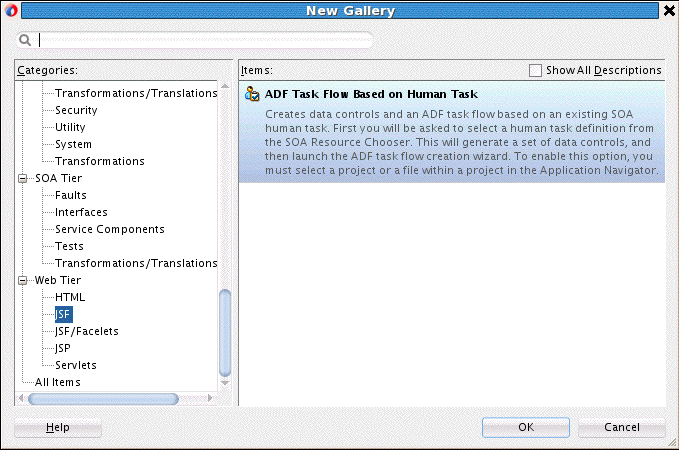
Description of "Figure 30-1 ADF Task Flow Based on a Human Task, in Oracle JDeveloper"
30.1.1 What You May Need to Know About Task Forms: Time Zone Conversion
Time zone conversion is not automatic for datetime elements in the task payload when a task form is created. You must add the <af:convertDateTime> tag to enable time zone conversion on a datetime element. See any standard task header time label for an example. The following example shows a sample header:
<af:outputText value="#{bindings.createdDate.inputValue}"
id="ot15">
<f:convertDateTime type="#{pageFlowScope.dt}"
timeZone="#{pageFlowScope.tz}"
dateStyle="#{pageFlowScope.df}"
timeStyle="#{pageFlowScope.tf}"/>
</af:outputText> 30.2 Associating the Task Flow with the Task Service
When you create an ADF task flow based on a human task, you must select a task metadata file to generate the data control. This data control is used to lay out the content on the page and connect to the workflow service engine at execution time to retrieve task content and act on tasks.
The hwtaskflow.xml file is used to capture the details on connecting with the service engine. By default, it uses remote EJBs to connect to the workflow server. The SOA server URL and port are automatically determined by using WebLogic Server runtime MBeans. However, you can override these by explicitly specifying the URL and port information here.
Seed a user that has ORMI privileges so that the task details application can connect to the workflow service. You can seed this user by using Oracle Enterprise Manager Fusion Middleware Control.
30.3 Creating an ADF Task Flow Based on a Human Task
ADF task flows are used to model the user interface for the task details page. You can create the task flow in the same application that contains the human task or in a separate application.
You must have previously created a human task (.task file) as part of a SOA composite before you can create a task flow. See Creating Human Tasks for how to create the.task file.
If the task flow is in the same application as the human task, create a different project for the task flow. If the SOA composite contains multiple human tasks, create a separate project for each ADF task flow associated with each human task. By using an ADF task flow, you create data controls based on the task parameters and outcomes.
To autogenerate an ADF task form, access the human task in the SOA composite application (form and task are in the same application). See How To Create an ADF Task Flow from the Human Task Editor, for more information.
To create an ADF task form in a separate application, create the new application and project and browse for the .task file for the human task. See How To Create an ADF Task Flow Based on a Human Task, for more information.
An ADF task form does not validate user inputs. The only validation that is done is to check that mandatory inputs have values. You should review your task forms and add additional validators as needed.
30.3.1 How To Create an ADF Task Flow from the Human Task Editor
The.task file that specifies the human task is easily associated with the task flow when the two are located in the same application.
To create an ADF task flow for a human task:
The task flow and task form are complete and ready to be deployed.
30.3.2 How To Create an ADF Task Flow Based on a Human Task
The ADF Task Flow Based on Human Task option (shown in Figure 30-1) creates an ADF task flow and additional artifacts to make deployment easier. When you select the .task file to associate with the ADF task flow, human task data controls are created based on the task parameters and outcomes. These are then available to use in the JSPX page. You must have access to the SOA composite project while creating the task flow project.
To create an ADF task flow based on a human task:
-
From the File main menu, select New > Applications > Custom Application.
-
Click OK.
-
Provide an application name and directory information (or accept the default), and click Finish.
-
Right-click the project name and select New.
-
Under Web Tier, select JSF.
-
Select ADF Task Flow Based on Human Task and click OK.
-
In the SOA Resource Browser, find and select the
.taskfile where you defined the human task and click OK.-
If the human task is in the same application as the task definition, then click File System to use the file browser to navigate to the
.taskfile, which is typically in the composite directory. -
If the human task is in a different application, then click SOA-MDS to use the MDS resource catalog and find the
.taskfile in the composite application. -
If the
.taskfile is located within the current application, then click Application.
This displays the Create Task Flow dialog and creates the data controls.
-
-
In the Create Task Flow dialog, accept the defaults and click OK.
The taskDetails1_jspx icon appears in the designer, as shown in Figure 30-4. The task flow has a view, a control flow, and a task return.
To continue creating the task form, see the following:
30.3.3 What Happens When You Create an ADF Task Flow Based on a Human Task
With an ADF task flow based on a human task, the task flow application has task data controls that wire the task form with the workflow services. The data controls provide the following:
-
Various parameters and operations to access task data and act on it
-
Drop handlers with which you can create interface regions to display the contents of the task
The human task-aware data controls appear in the Data Controls panel of the Oracle JDeveloper Applications window, as shown in Figure 30-5.
Figure 30-5 The Task Collection in the Data Controls Panel
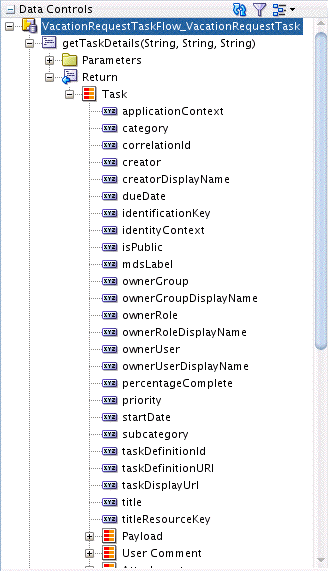
Description of "Figure 30-5 The Task Collection in the Data Controls Panel"
The data controls for the task (represented by the Task node in Figure 30-5) have drop handlers to render the task form. See Creating a Task Form, for more information.
30.3.4 What You May Need to Know About Having Multiple ADF Task Flows That Contain the Same Element with Different Meta-attributes
You must create separate ADF task flows if both contain the same element, but with different meta-attributes specified (for example, editable and noneditable).
For example, assume you perform the following tasks.
-
Create two task form applications for a SOA composite application:
-
Task form application one (for example, named EnterBankDetails.task) has one editable payload (for example, named BankDetails) and one noneditable payload (for example, named Employee).
-
Task form application two (for example, named ValidatePersonalInformation.task) has one editable payload (for example, also Employee).
While creating the task form, the wizard provides you with the option to define the ADF table for payload Employee.
-
-
Complete the wizard, then deploy the process.
-
Invoke the process.
-
Log in to Oracle BPM Worklist.
There is a Validate Personal Information task (for ValidatePersonalInformation.task).
-
Select the task.
Employee details are available for modification, as expected.
-
Add a new record, then approve the task.
-
Select the Enter Bank Details task (for EnterBankDetails.task). In the task form, the Insert New and Delete buttons are still present for Employee data, even though it is a noneditable payload.
-
Click Delete, then select Approve. The payload gets deleted.
Ensure that you create two separate ADF task flow applications because both contain the Employee element, but with different meta-attributes specified (editable and noneditable).
30.4 Creating a Task Form
You can create a task form by using the Auto-Generate Task Form option, the Launch Task Form Wizard option, or by using human task drop handlers.
-
For how to use the Auto-Generate Task Form option, see How To Create an Autogenerated Task Form.
-
For how to use the Launch Task Form Wizard option, see How To Create a Task Form Using the Custom Task Form Wizard.
-
For how to use human task drop handlers, see the following:
Note:
A task form name must begin with a letter of the alphabet, either upper or lower case. It should contain only letters of the alphabet and the numbers zero (0) through nine (9).
30.4.1 How To Create an Autogenerated Task Form
Autogenerating a task form opens a default template that you can then modify.
To create an autogenerated task form:
30.4.2 How to Register the Library JAR File for Custom Page Templates
You can optionally specify your own custom page templates in the Custom Task Form wizard. As described in How To Create a Task Form Using the Custom Task Form Wizard, you select Custom in the Name and Definition page of the Custom Task Form Wizard and select the library and .jspx template.
As a prerequisite, you first must register the library JAR file in Oracle JDeveloper.
To create the library JAR file for custom page templates:
30.4.3 How To Create a Task Form Using the Custom Task Form Wizard
This wizard enables you to create a task form using ADF page templates and standardized task regions. The page templates can be either of the following:
-
Default page templates that are automatically provided at the following location:
[JDeveloper_Home}/jdeveloper/soa/modules/oracle.soa.worklist_11.1.1/adflibWorklistComponents.jarThe default page templates are:
-
Nontabbed, default template:
taskDetailsTemplate.jspx -
Tabbed templates in which the payload and comments, attachment, and history sections are displayed on a separate tab:
taskDetailsTemplate2.jspx
In the Name and Definition page of the Custom Task Flow wizard, select Packaged, then select either Default or Tabbed.
-
-
Custom page templates that you define. In the Name and Definition page of the Custom Task Flow wizard, select Custom, then select the library name and the template name.
You package a page template and its artifacts into an ADF library JAR file. These JAR files can be packaged, deployed, discovered, and used like any other Oracle library component. The wizard prompts you to specify the JAR name and template location in the JAR.
Page templates let you define entire page layouts, including values for certain attributes of the page. When pages are created using a template, they all inherit the defined layout. When you make layout modifications to the template, all pages that consume the template automatically reflect the layout changes.
The templates used in the wizard generate content for the following six facets:
-
Actions
-
Attachments
-
Body
-
Comments
-
Header
-
History
For the action, header, and body facets, you can pick the content and attributes to be displayed and then fine tune the layout.
All six facets are defined in the default page templates. In the case of custom templates, you use these exact facet names in your template. If your template does not include these facets, then the facet content is not generated in the JSPX file.
To create a custom task form:
30.4.4 How To Create a Task Form Using the Complete Task with Payload Drop Handler
The human task drop handlers appear in the context menu of the designer, as shown in Figure 30-17.
Figure 30-17 Human Task Drop Handlers for Creating the Task Form

Description of "Figure 30-17 Human Task Drop Handlers for Creating the Task Form"
Other ADF drop handlers—for forms, tables, trees, and so on (shown in Figure 30-17)—can also be used to create task forms.
To create a task form using the Complete Task with Payload drop handler:
30.4.4.1 Complete Task with Payload
This option creates the combination of all the preceding task form components (the task header, task history, task actions, and task comments and attachments), plus the interface for the payload. The payload interface is created as follows:
-
All text nodes are created as text input fields.
-
If an element has
maxOccurs="unbounded", then it appears as a table. -
Nested tables are not rendered; that is, if an element has
maxOccurs="unbounded"and it has a child withmaxOccurs="unbounded", then the child element is not rendered. -
If there are multiple levels of nesting, then drag and drop the individual sections and use a standard ADF drop handler.
30.4.4.2 Complete Task without Payload
This option creates the combination of all of the preceding task form components (the task header, task history, task actions, and task comments and attachments).
30.4.4.3 Task Details for Email
This option creates an ADF region that renders well when sent by email. It generates the form shown in Figure 30-21.
Figure 30-21 Task Form for Email Notification

Description of "Figure 30-21 Task Form for Email Notification"
See Creating an Email Notification , for more information.
30.4.4.4 Task Header
All the standard header fields are added to the task form. This includes the task number and title; the state, outcome, and priority of the BPEL process, and information about who created, updated, claimed, or is assigned to the task. The header also displays dates related to task creation, last modification, and expiration. You can add or remove header fields as required for your task display.
Figure 30-22 shows an example of header information.
Buttons for task actions are also created in the header, as shown in Figure 30-23.
Figure 30-23 Task Header: Task Action Buttons

Description of "Figure 30-23 Task Header: Task Action Buttons"
30.4.4.5 Task Actions
The following task actions appear from the Actions dropdown list or as buttons. The tasks that appear depend on the state of the task (assigned, completed, and so on) and the privileges that are granted to the user viewing the task. For example, when a task is assigned to a group, only the Claim button appears. After the task is claimed, other actions such as Reject and Approve appear.
The first three custom actions appear on the task form as buttons: Claim, Dismiss, and Resume. Only those buttons applicable to the task appear. Other actions are displayed under the Actions list, starting with Request for Information, Reassign, and Route. Systems actions—Withdraw, Pushback, Escalate, Release, Suspend, and Renew—follow the custom actions, followed by the Save button. These actions require no further dialog to complete.
-
Claim—A task that is assigned to a group or multiple users must be claimed first. Claim is the only action available in the Task Action list for group or multiuser assignments. After a task is claimed, all applicable actions are listed.
Note:
-
If an FYI task is sent to multiple users, a user must first select the Claim button to claim the task before they can dismiss it.
-
Pushback is designed to work with single approvers and not with group votes. Pushback from a stage with group vote (or parallel) scenario to another stage is not allowed. Similarly, you cannot push back from a single assignee to a group vote (or parallel) scenario.
-
-
Dismiss—This action is used for a task that requires the person acting on the task to acknowledge receipt, but not take any action (such as an FYI).
-
Resume—A task that was halted by a Suspend action can be worked on again. See Suspend.
-
Request for Information—You can request more information from the task creator or any of the previous assignees. If reapproval is not required, then the task is assigned to the next approver or the next step in the business process.
-
Reassign—Managers can reassign a task to reportees. The Reassign option also provides a Delegate function. A task can be delegated to another user or group. The delegated task appears in both the original user's and the delegated user's worklists. The delegated user can act on behalf of the original assignee, and has the same privileges for that task as the original assignee.
-
Route—If there is no predetermined sequence of approvers or if the workflow was designed to permit ad hoc routing, then the task can be routed in an ad hoc fashion. For such tasks, a Route button appears on the task details page. From the Routing page, you can look up one or more users for routing. When you specify multiple assignees, you can choose whether the list of assignees is for simple (group assignment to all users), sequential, or parallel assignment. In the case of parallel assignment, you provide the percentage of votes required for approval.
-
Withdraw—Only the task creator can withdraw (cancel) the task. The Comments area is available for an optional comment. The business process determines what happens next.
-
Pushback—This action sends a task up one level in the workflow to the previous assignee. Note: Pushback is designed to work with single approvers and not with group votes. Pushback from a stage with group vote (or parallel) scenario to another stage is not allowed. Similarly, you cannot push back from a single assignee to a group vote (or parallel) scenario.
-
Escalate—An escalated task is assigned to the user's manager. The Comments area is available for an optional comment.
-
Release—Releasing a task makes it available to other assignees. A task assigned to a group or multiple users can then be claimed by the other assignees.
-
Suspend—This action suspends the expiration date indefinitely, until the task is resumed. Suspending and resuming tasks are available only to users who have been granted the
BPMWorkflowSuspendrole. Other users can access the task by selecting Previous in the task filter or by looking up tasks in the Suspended status. Buttons that update a task are disabled after suspension. -
Renew—Renewing a task extends the task expiration date seven days (
P7Dis the default). The renewal duration is controlled from Oracle Enterprise Manager Grid Control. A renewal appears in the task history. The Comments area is available for an optional comment. -
Save—Changes to the task are saved.
While you are creating a task form, all possible system action buttons appear, although only those actions that are appropriate for the task state and fit the user's privileges appear in the worklist.
30.4.4.6 Task History
The history of task actions appears on the task details page, and is displayed in the worklist as a history table. The history includes the following fields:
-
Version number
-
Participant name—the person who acted on the task
-
Action—for example, if the task was approved or assigned
-
Updated By—name of the person who last updated the task
-
Action date
See Figure 32-20 and Figure 32-21 for how task history is displayed in Oracle BPM Worklist, including the options to take a history snapshot, list future participants, and list full task actions.
30.4.4.7 Task Comments and Attachments
A trail of comments with the comment date and comment writer's user name is maintained throughout the life cycle of a task.
Files or reference URLs associated with a task can be added by any of the human task participants.
Figure 30-24 shows an example of the comments and attachments region.
Figure 30-24 Comments and Attachment Region

Description of "Figure 30-24 Comments and Attachment Region"
30.4.5 How To Create Task Form Regions Using Individual Drop Handlers
You can create a display form with multiple regions using the individual Task Header, Task Action, Task History, and Task Comment and Attachment drop handlers shown in Figure 30-25.
Figure 30-25 Using Human Task Drop Handlers

Description of "Figure 30-25 Using Human Task Drop Handlers"
Task Header provides both header and task actions, so you do not need the Task Action drop handler when you use Task Header. Use Task Action when you want the actions dropdown menu and buttons, but not header details.
To create the task form without building each region individually, see How To Create a Task Form Using the Complete Task with Payload Drop Handler.
Before you create this task form, you must have created the following:
-
A new application and SOA project, and a human task service.
-
An ADF task flow based on the human task. See Introduction to the Human Workflow Tutorial for more information.
To create task form regions using individual drop handlers:
To continue creating the task form, see Step 1 in How To Add the Payload to the Task Form.
30.4.6 How To Add the Payload to the Task Form
In addition to adding the payload, you can create task form regions. See Step 1 in How To Create Task Form Regions Using Individual Drop Handlers.
To add the payload to the task form:
The task form, shown in Figure 30-30, is complete and ready to be deployed.
Figure 30-30 The Task Form (taskDetails.jspx)
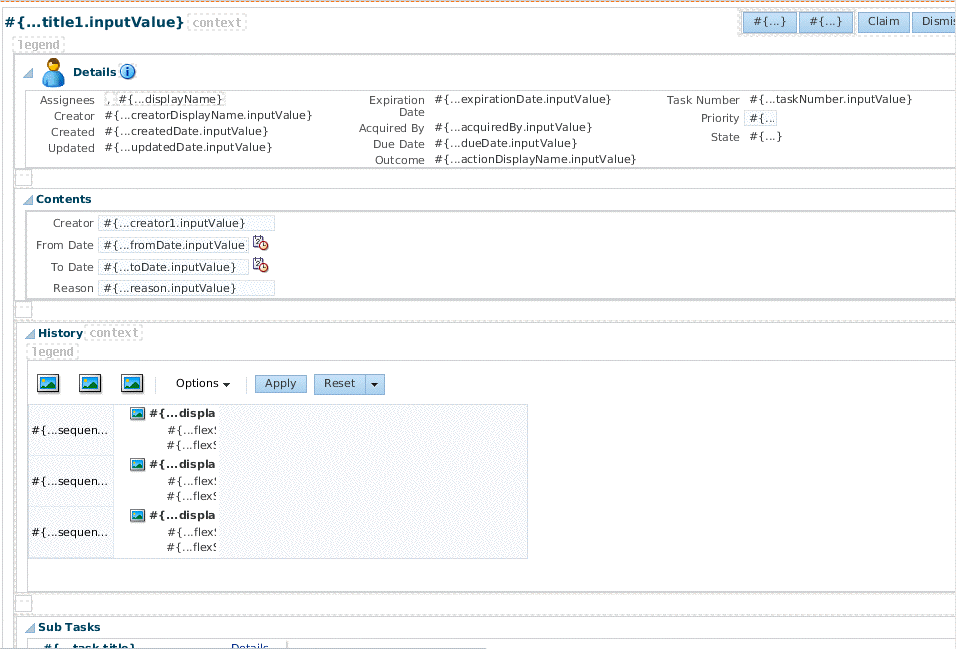
Description of "Figure 30-30 The Task Form (taskDetails.jspx)"
30.4.7 What Happens When You Create a Task Form
The form you designed is saved in the .jspx file at
JDev_Oracle_Home\mywork\task_form_application_name\project_name\public_html
The task form is ready to be deployed. See Deploying a Composite Application with a Task Flow.
30.5 Refreshing Data Controls When the Task XSD Changes
When task metadata changes, refresh the Data Controls view (XSD changes are not refreshed) that is based on that task metadata.
The refresh functionality re-creates the data control. Figure 30-31 shows the Refresh option.
To refresh the data control:
30.6 Securing the Task Flow Application
You can use any container-based security for securing the task flow.
See Requirements for Client Applications For Identity Propagation , for more information. Form-based authentication and SSO-based authentication are available for web security.
If you are sending a notification as email, do not secure the URL with "/notification/secure" to use container-based security because this is accessed by SOA APIs using an internal context that cannot be created outside of SOA. The URL pattern inside security cannot contain "/" (all URLs) and "//notification".
No additional steps are required for identity propagation. Identity is automatically propagated to the server EJBs.
30.7 Creating an Email Notification
A task form is used to provide an email notification, if email notification is defined as part of the human task.
Options for email notification include:
-
Default email notification—Use the first page of the task form that you create for the human task. The content is sent as an HTML-based email. Images in the task flow are included as attachments so that the notification can be viewed in disconnected mode. All drop handlers, including Complete Task with Payload and Complete Task without Payload, are suitable for emails.
-
Custom email notification—Use the Task display for email drop handler to create a custom email notification task page.
Notifications from Human Workflow to review notification settings as part of a human task definition (.task file).
30.7.1 How To Create an Email Notification
To send a custom email notification whose content and layout you have specified, create another JSPX file in which you design an email notification page. (Note, however, that you can use the default page for notification with no further modifications.) Create the custom notification page by using the custom and standard drop handlers, or use the email notification drop handler. In addition, do the following:
-
Add a router to the task flow. The router directs the task flow to send either the email notification page or the default page, depending on the control flow based on the
bpmClientTypepage flow scope value. -
Edit the generated inline CSS to customize the page. No additional CSS is included at runtime and the ADF CSS is not available at runtime. See the samples notification-101 and notification-102 available with the Oracle SOA Suite samples.
-
Reference images directly from the HTML or JSF page. (Indirect references, for example, an included JSF that in turn includes the image, are not allowed.)
30.7.1.1 Creating a Task Flow with a Router
The control flow case with a router enables you to direct the request to a specific page based on certain parameters. For an ADF task flow based on a human task, you need a special page for email notifications. This section describes how to create a special page for email notifications.
To create a task flow with a router:
To continue creating the email notification page, see Step 1 in Creating an Email Notification Page.
30.7.2 What Happens When You Create an Email Notification Page
The email notification page is sent as HTML content in the email message body. Images on the page are inlined as attachments. Relative URLs are converted to absolute URLs.
A notification may not display correctly in email if the styles used in the fields of the form are not valid for email. Editing the generated inline CSS to customize the page may be required. See How To Create an Email Notification, for more information.
Security issues can also prevent the form from being rendered correctly. See Securing the Task Flow Application, for more information.
30.8 Deploying a Composite Application with a Task Flow
The composite application that contains the task flow must be deployed before you can use the task form in the Worklist Application.
The process for deploying an application with a task flow is basically the same as deploying any SOA composite application, as described in How To Deploy a Composite Application with a Task Flow. See Deploying SOA Composite Applications for more information.
30.8.1 How To Deploy a Composite Application with a Task Flow
An application server connection is required to do the following.
To deploy a composite application with a task flow:
30.8.2 How To Redeploy the Task Form
If you change the task form and want to redeploy it, repeat the deployment step. (Right-click the task form application name, select Deploy, and then application_name > to > application_server_connection.) A message asking you if you want to undeploy the form is displayed. Click OK and deploy the task form again.
30.8.3 How To Deploy a Task Flow as a Separate Application
If you want to deploy the task flow as a separate application, outside of the SOA composite application, then create an application and project as a container for the task flow. After you deploy the SOA composite application, deploy the task flow application.
30.8.4 How To Deploy a Task Form to a non-SOA Oracle WebLogic Server
This section describes how to deploy a task form to a non-SOA Oracle WebLogic Server.
30.8.4.1 Before Deploying the Task Form: Port Changes
If you are not using the default values for RMI or HTTP ports, open the wf_client_config.xml file in Oracle JDeveloper to change values.
When you want to deploy task details on non-SOA servers, you must configure the wf_client_config.xml file. This file should be created and added to the task details project only if the task detail is deployed to a separate managed server that is not the SOA server. The <serverURL> and <rootEndpointURL> in the file should refer to the SOA server host name and port number.
The following example shows a sample wf_client_config.xml file.
<?xml version="1.0" encoding="UTF-8" ?>
xmlns="http://xmlns.oracle.com/bpel/services/client">
<server default="true" name="default">
<localClient>
<participateInClientTransaction>false</participateInClientTransaction>
</localClient>
<remoteClient>
<serverURL>t3://my_host.us.example.com:8001</serverURL>
<initialContextFactory>weblogic.jndi.WLInitialContextFactory</initialContextFactory>
<participateInClientTransaction>false</participateInClientTransaction>
</remoteClient>
<soapClient>
<rootEndPointURL>http://my_host.us.example.com:8001</rootEndPointURL>
</soapClient>
</server>
</workflowServicesClientConfiguration>30.8.4.2 Configuring Unique Cookie Context Paths for the Session Tracking Cookies
Before deploying the task form to a non-SOA Oracle Weblogic Server, ensure that the session tracking cookie of your task-form web application is configured with a cookie trigger path unique to your application. This ensures that your task form application has its unique session tracking cookie and cannot be overwritten by the session tracking cookies created for other Oracle BPM applications such as Oracle BPM Worklist or Oracle Business Process Management Workspace.
To configure the session cookie trigger path, in JDeveloper, open the weblogic.xml file in your web project. Choose the overview tab in your .xml file editor, and choose the session. In the cookie trigger path field, enter the application context path of your web application. For example, if the URL of your application is http://host:port/my-application-context-root in which my-application-context-root is the name of your application context root, then the cookie trigger path is set as follows:
/my-application-context-root
30.8.4.3 Deploying oracle.soa.workflow.jar to a non-SOA Oracle WebLogic Server
The oracle.soa.workflow.jar shared library is needed on the non-SOA Oracle WebLogic Server. It is available from
ORACLE_JDEV_HOME\jdeveloper\soa\modules\oracle.soa.workflow_11.1.1
Use Oracle WebLogic Server Administration Console to deploy the JAR file.
To deploy oracle.soa.workflow.jar:
See Defining the Foreign JNDI Provider on a non-SOA Oracle WebLogic Server, to continue.
30.8.4.4 Defining the Foreign JNDI Provider on a non-SOA Oracle WebLogic Server
Use Oracle WebLogic Server Administration Console to complete this portion of the task.
To define the foreign JNDI provider:
30.8.4.5 Defining the Foreign JNDI Provider Links on a non-SOA Oracle WebLogic Server
Use Oracle WebLogic Server Administration Console to complete this portion of the task.
To define the foreign JNDI provider links:
See Including a Grant for bpm-services.jar, to continue.
30.8.4.6 Including a Grant for bpm-services.jar
To include a grant for bpm-services.jar, edit the system-jazn-data.xml file and then restart the non-SOA Oracle WebLogic Server.
To include a grant for bpm-services.jar:
See Deploying the Application, to continue.
30.8.4.7 Deploying the Application
Deploy the application that contains the task form to a non-SOA Oracle WebLogic Server the same way other applications are deployed. When you set up the application server connection, specify the domain on the non-SOA server (the domain you specified in Step 1 of Including a Grant for bpm-services.jar.. See Deploying SOA Composite Applications for information on deploying applications.
30.8.5 What Happens When You Deploy the Task Form
When the task form is deployed, an automatic association is created between the task metadata and the task flow application URL. Use Oracle Enterprise Manager Fusion Middleware Control to update this mapping. Access the task flow component in the Component Metrics table for a specific SOA composite application. The Administration tab shows the URI for the task form. See Administering Oracle SOA Suite and Oracle Business Process Management Suite for more information. If the task flow is configured for HTTPS access, you may need to do additional settings in Enterprise Manager.
Note:
For the task form association to happen automatically, the SOA server must be running. If the association does not happen, then you receive the message Task details not found for this task when you try to access the task form for that task in Worklist Application or Oracle Business Process Management Workspace. In this case, you can either restart the application or go to Oracle Enterprise Manager and register the task form URL manually.
See Using for information on how to act on tasks.
Note:
-
For the task form to work correctly, always specify the URL using the complete name for the host on which the task flow is deployed.
-
If you want to access the task form from a different URL that has a different port number than the hostname and port number previously set in Oracle WebLogic Server Administration Console, then you must change the port number for the front-end in Oracle WebLogic Server Administration Console and redeploy the task form so that the task details appear correctly in the worklist.
30.8.6 What You May Need to Know About Undeploying a Task Flow
When a task flow Web application is deployed, the task flow URL is registered in the database. This URL is displayed in Oracle BPM Worklist when a task is clicked and the task details are displayed. If the task flow Web application is later undeployed or stopped, the task flow URL in the database is not removed as part of the undeployment. Consequently, when you click the task in the worklist to see the task details, a 404 Not Found error is displayed rather than the message Details not available for task. To avoid the 404 Not Found error, use Oracle Enterprise Manager Fusion Middleware Control to undeploy the task flow application from the application home page.
30.9 Displaying a Task Form in the Worklist
The task form is displayed in Oracle BPM Worklist, a web-based interface for users to act on their assigned human tasks. Specific actions are available or unavailable depending on a user's privileges.
Figure 30-47 shows how the task form for the help desk request example is displayed in the Worklist Application task details page.
The task form is available in Oracle BPM Worklist after you log in. See How To Log In to the Worklist for instructions.
30.10 Displaying a Task in an Email Notification
Learn how to display a task in an email notification.
Figure 30-48 shows how an email task notification appears in email.
You can click an available action, RESOLVED or UNRESOLVED, or click the Worklist Application link to log in to the worklist. Clicking an action displays an email composer window in which you can add a comment and send the email.
By default, the text in a task notification refers to "Worklist Application," but you can change that text and its associated URL.
30.10.1 Changing the Text for the Worklist Application in Task Notifications
By default, the text in a task notification refers to "Worklist Application," but you can change that text. To change it, you create a custom resource bundle and modify the appropriate strings.
To change the text in a task notification:
30.10.2 Changing the URL of the Worklist Application in Task Notifications
To change the text in a task notification:
For information about showing or hiding the URL of the Worklist Application, see How to Display the URL in Notifications.
30.11 Reusing the Task Flow Application with Multiple Human Tasks
You can reuse a single task flow application with multiple human tasks. To use this feature, all human tasks must have both the payload elements and the outcomes must be identical.
30.11.2 How to Reuse the Task Flow Application with Different Actions
You can reuse a single task flow that has different actions for different tasks. To do this:
- Define all actions in the task that you use to generate the taskflow.
- In any given task, disable the actions that you do not want to include.
